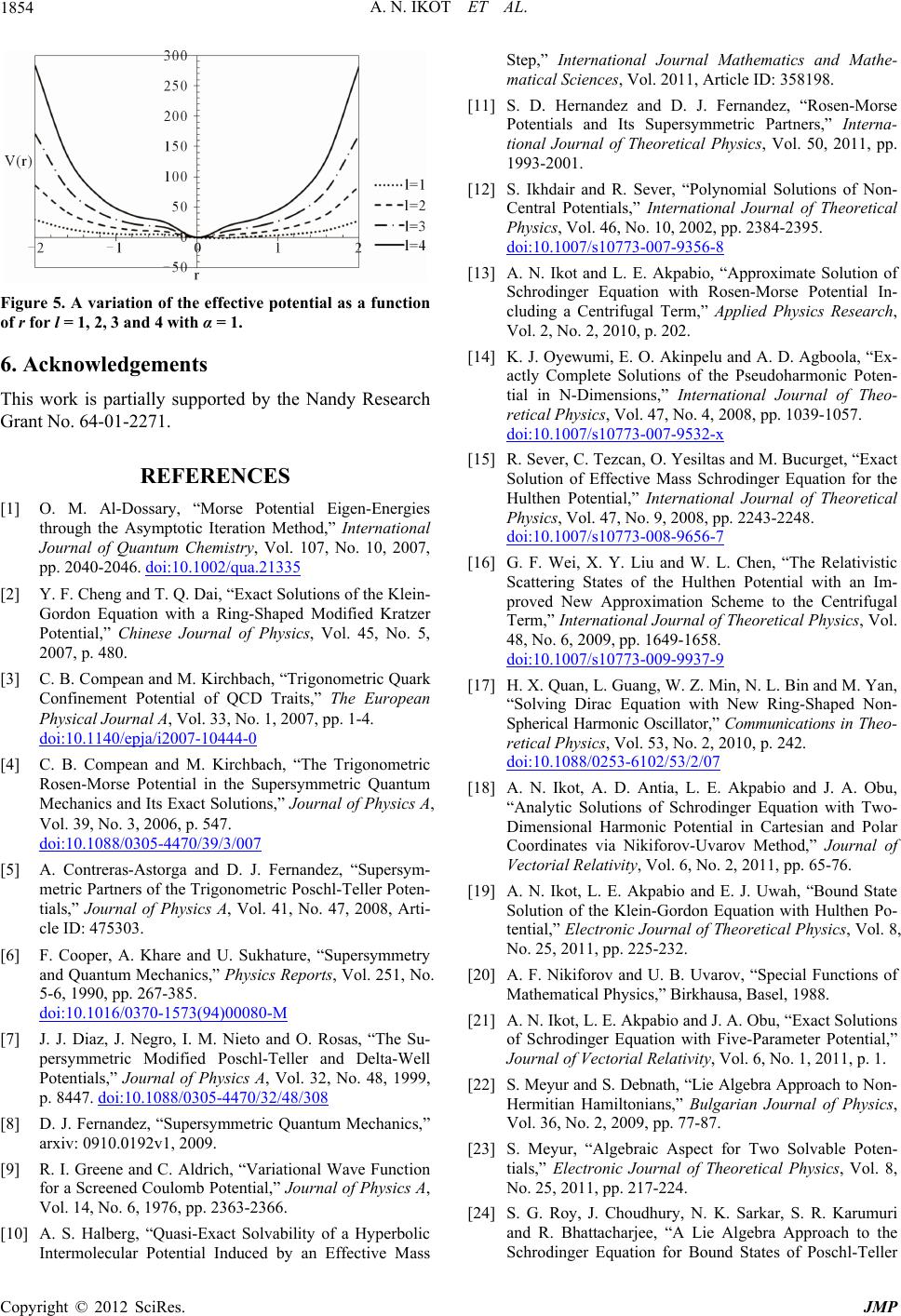
A. N. IKOT ET AL.
1854
Figure 5. A variation of the effective potential as a function
of r for l = 1, 2, 3 and 4 with α = 1.
k is partially supported by the Nandy Resea
Grant No. 64-01-2271.
REFERENCES
[1] O. M. Al-Dossary, “Morse Potential Eigen-Energies
through the Asymptotic Iteration Method,” International
Journal of Quantum Chemistry, Vol. 107, No. 10, 2007
pp. 2040-2046. doi:10.1002/qua.21335
6. Acknowledgements
This worrch
,
[2] Y. F. Cheng and T. Q. Dai, “Exact Solutions of the Klein-
Gordon Equation with a Ring-Shaped Modified Kratze
Potential,” Chinese Journal of Physics, Vol. 45, No. 5,
ch, “Trigonometric Quark
QCD Traits,” The European
3, No. 1, 2007, pp. 1-4.
r
2007, p. 480.
[3] C. B. Compean and M. Kirchba
Confinement Potential of
Physical Journal A, Vol. 3
doi:10.1140/epja/i2007-10444-0
[4] C. B. Compean and M. Kirchbach, “The Trigonometric
Rosen-Morse Potential in the Supersymmetric Quantum
Mechanics and Its Exact Solutions,” Journal of Physics A
Vol. 39, No. 3
doi:10.1088/030
,
, 2006, p. 547.
5-4470/39/3/007
[5] A. Contreras-Astorga and D. J. Fernandez, “Supersym-
metric Partners of the Trigonometric Poschl-Teller Poten-
tials,” Journal of Physics A, Vol. 41, No. 47, 2008, Arti-
cle ID: 475303.
[6] F. Cooper, A. Khare and U. Sukhature, “Supersymmetry
and Quantum Mechanics,” Physics Reports, Vol. 251, No.
5-6, 1990, pp. 267-385.
doi:10.1016/0370-1573(94)00080-M
, 1999,
2/48/308
[7] J. J. Diaz, J. Negro, I. M. Nieto and O. Rosas, “The Su-
persymmetric Modified Poschl-Teller and Delta-Well
Potentials,” Journal of Physics A, Vol. 32, No. 48
p. 8447.
doi:10.1088/0305-4470/3
” Journal of Physics A
, Article ID: 358198.
cal Physics, Vol. 50, 2011, pp.
[8] D. J. Fernandez, “Supersymmetric Quantum Mechanics,”
arxiv: 0910.0192v1, 2009.
[9] R. I. Greene and C. Aldrich, “Variational Wave Function
for a Screened Coulomb Potential,,
Vol. 14, No. 6, 1976, pp. 2363-2366.
[10] A. S. Halberg, “Quasi-Exact Solvability of a Hyperbolic
Intermolecular Potential Induced by an Effective Mass
Step,” International Journal Mathematics and Mathe-
matical Sciences, Vol. 2011
[11] S. D. Hernandez and D. J. Fernandez, “Rosen-Morse
Potentials and Its Supersymmetric Partners,” Interna-
tional Journal of Theoreti
1993-2001.
[12] S. Ikhdair and R. Sever, “Polynomial Solutions of Non-
Central Potentials,” International Journal of Theoretical
Physics, Vol. 46, No. 10, 2002, pp. 2384-2395.
doi:10.1007/s10773-007-9356-8
[13] A. N. Ikot and L. E. Akpabio, “Approximate Solution of
Schrodinger Equation with Rosen-Morse Potential In-
. D. Agboola, “Ex-
cluding a Centrifugal Term,” Applied Physics Research,
Vol. 2, No. 2, 2010, p. 202.
[14] K. J. Oyewumi, E. O. Akinpelu and A
actly Complete Solutions of the Pseudoharmonic Poten-
tial in N-Dimensions,” International Journal of Theo-
retical Physics, Vol. 47, No. 4, 2008, pp. 1039-1057.
doi:10.1007/s10773-007-9532-x
[15] R. Sever, C. Tezcan, O. Yesiltas and M. Bucurget, “Exact
Solution of Effective Mass Schrodinger Equation for the
Hulthen Potential,” International Journal of Theoretical
Physics, Vol. 47, No. 9, 2008, pp. 2243-2248.
doi:10.1007/s10773-008-9656-7
[16] G. F. Wei, X. Y. Liu and W. L. Chen, “The Relativistic
Scattering States of the Hulthen Potential with an Im-
proved New Approximation Scheme to the C
Term,” International Journal of Tentrifugal
heoretical Physics, Vol.
48, No. 6, 2009, pp. 1649-1658.
doi:10.1007/s10773-009-9937-9
[17] H. X. Quan, L. Guang, W. Z. Min, N. L. Bin and M. Yan,
“Solving Dirac Equation with New Ring-Shaped Non-
Spherical Harmonic Oscillator,” Communications in The o-
retical Physics, Vol. 53, No. 2, 2010, p. 242.
doi:10.1088/0253-6102/53/2/07
[18] A. N. Ikot, A. D. Antia, L. E. Akpabio and J. A. O
“Analytic Solutions of Schroding
bu,
ound State
uation with Hulthen Po-
Solutions
of Physics,
o the
er Equation with Two-
Dimensional Harmonic Potential in Cartesian and Polar
Coordinates via Nikiforov-Uvarov Method,” Journal of
Vectorial Relativity, Vol. 6, No. 2, 2011, pp. 65-76.
[19] A. N. Ikot, L. E. Akpabio and E. J. Uwah, “B
Solution of the Klein-Gordon Eq
tential,” Electronic Journal of Theoretical Physics, Vol. 8,
No. 25, 2011, pp. 225-232.
[20] A. F. Nikiforov and U. B. Uvarov, “Special Functions of
Mathematical Physics,” Birkhausa, Basel, 1988.
[21] A. N. Ikot, L. E. Akpabio and J. A. Obu, “Exact
of Schrodinger Equation with Five-Parameter Potential,”
Journal of Vectorial Relativity, Vol. 6, No. 1, 2011, p. 1.
[22] S. Meyur and S. Debnath, “Lie Algebra Approach to Non-
Hermitian Hamiltonians,” Bulgarian Journal
Vol. 36, No. 2, 2009, pp. 77-87.
[23] S. Meyur, “Algebraic Aspect for Two Solvable Poten-
tials,” Electronic Journal of Theoretical Physics, Vol. 8,
No. 25, 2011, pp. 217-224.
[24] S. G. Roy, J. Choudhury, N. K. Sarkar, S. R. Karumuri
and R. Bhattacharjee, “A Lie Algebra Approach t
Schrodinger Equation for Bound States of Poschl-Teller
Copyright © 2012 SciRes. JMP